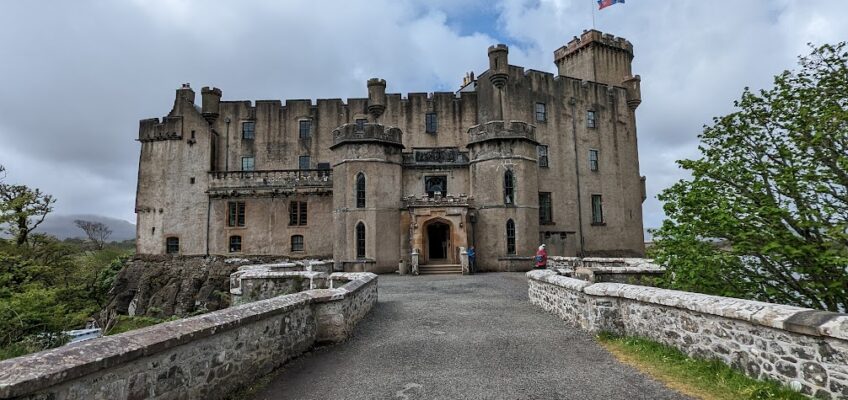For my first full day on the Isle of Skye, I decided to take a trip to Dunvegan Castle & Gardens.
I’m staying in Portree, which is the largest town on Skye, and the capital. (I don’t know what it means to be the capital of an island, but it is.) I’m staying four nights here, which is longer than anywhere else I’m going in Scotland except for Edinburgh. When I was planning this trip, everyone who gave me advice said I need lots of time on Skye.
The challenge was to figure out how to fill three days without a car.
I’d read about Dunvegan Castle, and I discovered that there’s a bus from Portree that stops right at the castle parking lot. I found the schedule online and it fit my timing perfectly. The bus from Portree left at 10:15 and arrived at the castle at 11:00. For the return, there was a bus at 2:30, getting back to Portree at 3:15.
Given the large numbers of tourists in Portree, I thought the bus might be crowded. It wasn’t. I was the only passenger. One other person got on along the way, but that was it.
The Gardens
When I arrived, it was not raining. So I figured now was a good time to explore the gardens, in case it started raining later (which it didn’t).
It’s still pretty early spring here in the northern latitudes. We’re actually as far north as Sitka, Alaska, though the climate here is far more temperate, thanks to the Gulf Stream.
Still, the gardens weren’t in the best of shape. Some of the earliest spring flowers were past their prime, and many others were just buds not ready to bloom.
Nevertheless, I got to see (and photograph) a lot of beautiful blossoms in the various gardens. The grounds are divided into a Water Garden, a Round Garden, a Woodland Garden, a Walled Garden, and a Rhododendron Garden.


The castle website has pictures of how the gardens look when they are at their best.
The Castle
Dunvegan Castle sits on an elevated rock overlooking Loch Dunvegan, which is not a lake but a sea loch (an inlet or fjord). The castle had its beginnings in the 13th century, with additions made over the centuries since.
In the 19th century an extensive renovation took place. The separate buildings on the site were joined together, and the front facade, in a Victorian/faux Medieval style, was added.
The castle has been the home of Clan MacLeod continuously for 800 years. The current Clan Chief, Hugh MacLeod, is the thirtieth chief in a line of succesion that goes back to Leod, son of a 13th-century Norse king.

The tour through the castle includes several rooms with lots of family portraits. There’s also evidence of how the current structure was superimposed over the medieval castle.
On the way back to Portree, I once again had the bus all to myself, except for one other passenger who got on after me and got off before me.
This isn’t the most opulent or impressive castle I’ve ever seen, but I didn’t know anything really about the Scottish clans before this trip. Visiting Dunvegan Castle gave me some fascinating insights about how the clans lived and how they were an integral part of life in medieval Scotland.












Leave a Reply